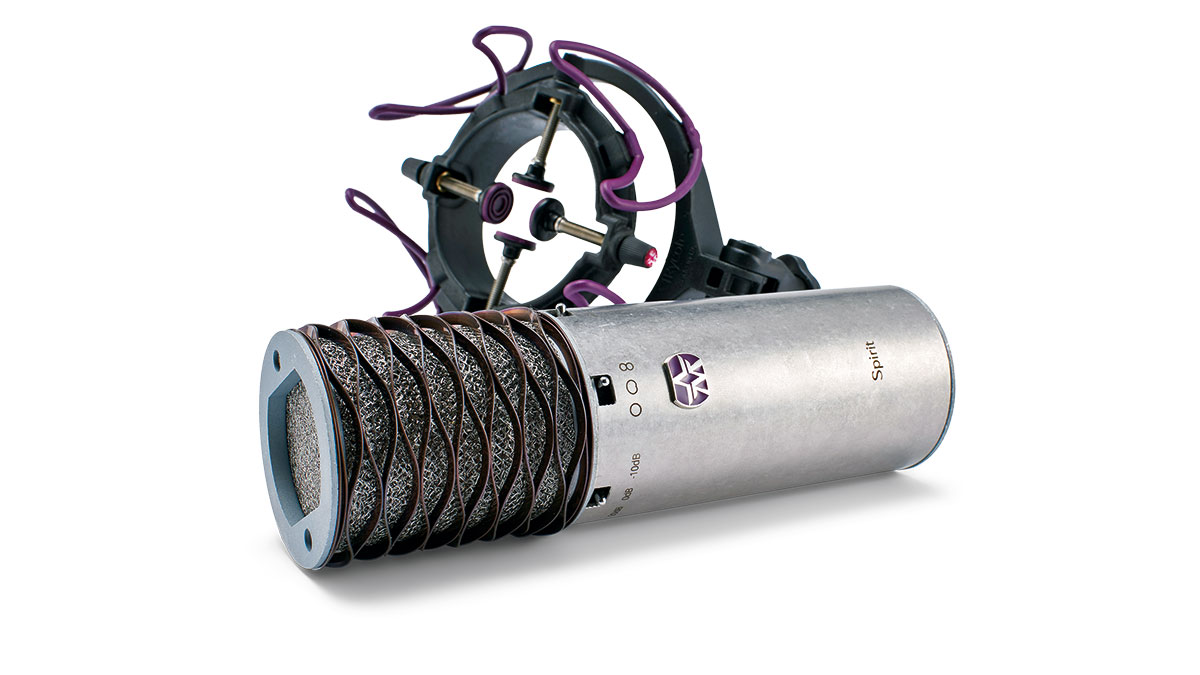MusicRadar Verdict
The Spirit is in C414 all-rounder territory, with its switchable polar patterns, a good balance of smooth low-end and detailed upper regions.
Pros
- +
A smooth frequency response with a nice touch of peak-free brightness.
Cons
- -
Will need a quality shockmount to get the best out of it.
MusicRadar's got your back
There may only be two mics in the Aston Microphones stable, but their wave-shaped spring mesh and stainless steel casing mark them out.
The Spirit moves on from the shorter Origin adding switchable polar patterns (cardioid, figure-8 and omnidirectional) and an extra 10dB of pad, on top of the 80Hz low-cut filter.
The Spirit has a solid build that seems like it will survive the beating that work-a-day mics can receive. It's not that heavy, but a counterweight can be necessary for safe boom stand extension.
The built-in 5/8-inch stand mount socket is fine for sessions where there is little floor/ stand noise and the low-cut filter can be engaged. For other situations we'd recommend a quality shockmount (diameter = 54mm). The review model was supplied with the new Aston USM cradle, which performs very well and, with screw braces, can accommodate a whole range of mics.
"The Spirit displays the same smooth mid range and high top as the Origin, but there is an additional brightness."
Though we didn't have the Origin for side-by-side testing, it is one of those responses we can recall, and the Spirit displayed the same smooth mid range and high top, but there is an additional brightness.
For vocals and many acoustic instruments this is a good thing, counterbalancing the low-mid proximity presence a little more when close micing. This brightness is not harsh or peaky, just a little more present.
We found the Spirit an easier mic to position on acoustic guitar, for example, with an instant quality tone in all three polar patterns. The figure-8 was a great match for the old Epiphone acoustic at my studio, and adding a double track using omni (to trim back the proximity-effect LMF tilt) was very pleasing; we would recommend the same technique for vocals and BVs, with cardioid on the former.
The Spirit is at its best as a vocal mic and with and acoustic instruments, but with the switchable polar patterns and low noise characteristic it also suits room mic and distant micing roles. The figure-8 makes it a good candidate for a clear 'side' in a mid- side pair arrangement.
The proximity effect response of the Spirit is not as strong as many condenser mics, making it a good mic for up-close vocals/ voiceovers in cardioid and figure-8 patterns. Luckily this does not carry through into an overly thin omni mode, where proximity no longer dominates, and we found it a great tool for balancing room and source on its own, and as part of a larger set-up.
The Spirit is 50% more expensive than the Origin, which we feel is reasonable. It is a slightly different mic with a more upfront condenser sound and would actually make a good partner in an m/s pairing. We'd factor in the expense of a shockmount, like the Aston USM, to get the most out of the Spirit. It will not disappoint.
- Hold your microphone steadfast with the best mic stands
- Explore more of the best XLR microphone options
“This is great. I knew I was getting to them! I’m so happy. It’s such a good feeling”: Spotify bites back at Kate Nash
“The included sample content is not only unique but sonically amazing, as it always was”: Spitfire Audio BBC Radiophonic Workshop review
“Don't kill him - he's Beatle Paul!”: The dramatic birth of Paul McCartney’s greatest post-Beatles song










